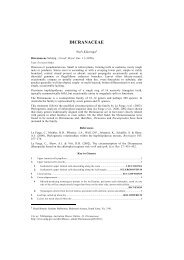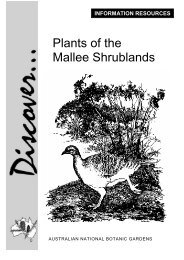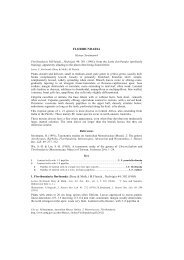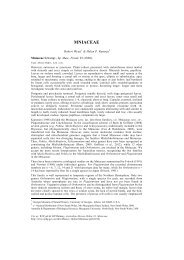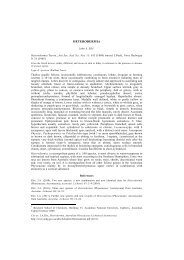Ptychostomum - Australian National Botanic Gardens
Ptychostomum - Australian National Botanic Gardens
Ptychostomum - Australian National Botanic Gardens
You also want an ePaper? Increase the reach of your titles
YUMPU automatically turns print PDFs into web optimized ePapers that Google loves.
1 Synoicous; peristome reduced, with a low basal membrane; cilia usually short; spores mostly > 20 µm diam.<br />
. ..................................................................................................................................... 1. P. altisetum<br />
1: Dioicous or synoicous; peristome well developed; spores < 20 µm diam. ............................................. 2<br />
2 Plants 1–5 (–10 cm) tall; stems elongate, with equidistant decurrent leaves, usually strongly<br />
tomentose, sparingly branched; laminal cells distinctly incrassate; costa percurrent to shortexcurrent;<br />
leaf border strong; upper margin denticulate (1:) .......................... 5. P. pseudotriquetrum<br />
2: Plants to 3 cm tall; leaves densely tufted, comose, not decurrent, tomentose below; laminal cells<br />
mostly thin-walled; costa short- to more commonly long-excurrent; leaf border variable, sometimes<br />
weak; upper margin usually entire or finely serrulate ....................................................................... 3<br />
3 Synoicous; leaf border distinct (2:) .......................................................................... 3. P. creberrimum<br />
3: Dioicous; leaf border weak or almost lacking ....................................................................................... 4<br />
4 Leaves ovate to ovate-lanceolate; upper and middle laminal cells elongate, 50–70 × 10–12 µm<br />
(5–6: 1) (3:)........................................................................................................ 2. P. angustifolium<br />
4: Leaves ovate to obovate; upper and middle laminal cells shorter and broader, 30–60 × 12–18 µm<br />
(3–4: 1) .......................................................................................................... 4. P. cylindrothecium<br />
1. <strong>Ptychostomum</strong> altisetum (Müll.Hal.) J.R.Spence & H.P.Ramsay, Phytologia 87:<br />
63 (2005)<br />
Bryum altisetum Müll.Hal., Hedwigia 37: 96 (1898). T: Moyston, Vic., Oct. 1883, D.Sullivan 551; lecto: H,<br />
fide H.Ochi, J. Fac. Educ. Tottori Univ. Nat. Sci. 21: 43 (1970); Dimboola, Vic., Oct. 1893, F.M.Reader 4;<br />
syn: H; near Hot Springs, Yarrangobilly Caves, N.S.W., W.W.Watts 8565; syn: NSW.<br />
Bryum humilisetum Müll.Hal., Hedwigia 37: 97 (1898), nom. inval. (in synon.); Bryum altisetum Müll.Hal. var.<br />
humilisetum Müll.Hal., Hedwigia 37: 96 (1898). T: Moyston, Vic., Oct. 1883, D.Sullivan 14d; holo: MEL.<br />
[Bryum inclinatum auct. non (Brid.) Bland: D.G.Catcheside, Mosses of South Australia 253 (1980)]<br />
Illustrations H.Ochi, J. Fac. Educ. Tottori Univ. Nat. Sci. 21: 44, fig. 25 (1970), as Bryum altisetum;<br />
A.J.E.Smith, Moss Flora of Britain and Ireland 398, fig. 187 (6–11) (1978), as Bryum inclinatum;<br />
D.G.Catcheside, Mosses of South Australia 254, fig. 145 (1980), as Bryum inclinatum.<br />
Synoicous. Plants to 10 mm tall, loosely to densely tufted, yellowish green. Leaves crowded<br />
above in comal tufts, appressed and straight to somewhat crisped when dry, erecto-patent<br />
when moist, ovate-lanceolate to oblong-lanceolate, 1.5–3.0 mm long, not or weakly<br />
decurrent, acuminate; base of leaf reddish; leaves of sterile innovations somewhat smaller<br />
and imbricate, concave; margin recurved, finely denticulate above, bordered by 3 or 4 rows<br />
of very narrow incrassate cells; costa short- to long-excurrent, yellowish to brown; upper and<br />
middle laminal cells 40–70 × 10–15 µm (3–4: 1), thin-walled; basal cells long-rectangular;<br />
angular cells at insertion of comal leaves inflated and reddish.<br />
Setae slender, 10–20 mm long. Capsules inclined to pendulous, narrowly pyriform, 1.5–3.5<br />
mm long, symmetrical; mouth yellowish; operculum mammillose. Peristome reduced;<br />
exostome teeth reddish below, yellow above, with lamellae; endostome segments with broad<br />
perforations, papillose along mid-line; basal membrane low; cilia rudimentary or 1 or 2 and<br />
short. Spores 18–25 µm diam. Chromosome number not known.<br />
Occurs in N.S.W., A.C.T. and Vic. and, possibly, in New Zealand. Grows in tufts on soil and<br />
rock, predominantly subalpine to alpine in Australia.<br />
N.S.W.: Yarrangobilly Caves, A.J.Downing s.n. (NSW); loc. id., W.W.Watts 8551 (NSW); Snowy<br />
Mtns, D.G.Catcheside 54.70 (AD). A.C.T.: Warks Rd, Brindabella Ra., H.Streimann 4749 (CANB).<br />
Vic.: Echo Flat, Lake Mtn, near Marysville, J.H.Willis 77 (MEL).<br />
<strong>Ptychostomum</strong> altisetum is most similar to Bryum inclinatum, a widespread, montane species<br />
in the Northern Hemisphere. However, there are subtle differences between the two species<br />
in leaf and peristome characters, and we prefer to maintain P. altisetum as a distinct species<br />
pending a worldwide revision.<br />
2





